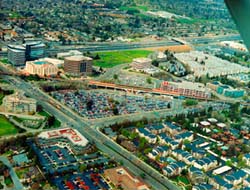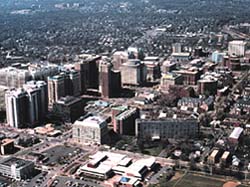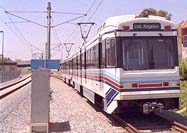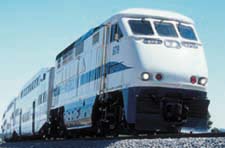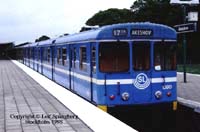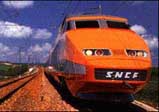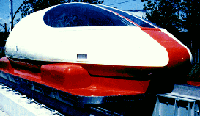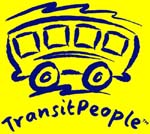
Getting people to use public transit is sometimes very difficult. One of the biggest problems is that transit companies can't afford to run buses or trains to places where not enough people will ride them. This is a big problem in some of the communities built after the car became popular. A lot of these communities are spread out. People don't live
A lot of people like to live this way. That's why they moved to the suburbs in the first place! But it makes it hard to design transit systems for them. Public transit works best when the community is designed around it. This doesn't mean everyone has to be jammed together in dirty, crowded buildings. Many older communities are already designed for transit; they were built when streetcars were still popular! The top photo at right shows a "transit village" of homes and offices surrounding the BART train station in Pleasant Hill, California. The train station is the diagonal line in the middle of the picture. Do you see how easy it is for the people who live and work here to take the train? Lots of them do; almost half of the people living near this station use BART to go to work!
The bottom photo shows an office complex built around the Ballston train station in Washington, D.C. The station entrance is in the clear area between the buildings near the center of the picture ... next to an International House of Pancakes! A lot of communities also make it much easier to walk or ride bicycles. Using bicycles is very good for the environment! In Amsterdam, people can use special credit cards to check out "white bikes" from a computer-controlled bicycle rack. They can put the bikes back into another rack after they ride where they want to go.
There are many different kinds of public transit. One kind that nearly everyone uses is the airplane. Not very many people have planes of their own!
Boats can be used as public transit, too. In this picture, a ferry boat takes commuters to San Francisco. Customers can buy sandwiches and drinks, and eat them while they stand on the deck and look at the bay. But they have to be careful not to fall in the water! Most of the time, though, public transit means traveling on land. One very popular form of public transit is the bus. Buses are much cheaper than trains, and seat fewer people. They're best at serving transit routes that aren't heavily used. Some planners think that buses
The city of Ottawa, Canada built a famous transit system using buses. Special busways run through the city. These are wide roads like freeways, but only buses can use them. More than 200,000 Ottawans ride the busways every day, and more than seventy percent of the trips downtown during the busiest hours are by public transit!
There are different kinds of trains used in public transit. Light rail trains, or trolleys, usually run over ground. They run on electricity from power lines over the train tracks. They can go as fast as fifty-five miles an hour, although they usually go much slower in the city. Light rail lines are more expensive than buses, but cheaper than heavy rail lines. The Blue and Green Line in Los Angeles are light rail lines. So are the Muni trains in San Francisco, the Portland MAX and the San Diego Trolley.
Some commuter trains run on electricity too. Others are powered by locomotives, just like the trains that transported people and products around the country before cars were invented. The locomotive -- the first car in the train -- holds a giant diesel engine. The engine is much, much bigger and more powerful than the engine in any car. It makes 3,000 horsepower and can pull a nine hundred thousand pound train over one hundred miles per hour.
Commuter trains often run on the same train routes built over a hundred years ago. They're called commuter trains because they run most often in the morning and the afternoon, when people need to go to and from work. Commuter trains often are nicer inside than most other types of trains. They sometimes have bathrooms, and big, comfortable chairs, and tables, so business people can do work while they're riding to the office.
Some communities grew up around commuter train routes nearly a hundred years ago, before hardly anyone was worried about the environment. Towns like Scarsdale, New Rochelle and Bronxville in New York are good examples. Heavy rail trains are also called subways, or metros. They usually run under the ground. The "Tube" in London, the Paris Metro and the Red Line in Los
Heavy rail trains go faster than light rail trains, and cost more to build. They get their power from a "third rail" next to the train tracks. This third rail is very dangerous! Heavy rail can be one of the most nicest forms of public
But heavy rail is expensive. Heavy rail systems make the most sense in places where lots and lots of people will ride them ... like through the center of big cities. How many people do you think there are in this crowded subway station in Washington, D.C.?
Monorails are a special kind of train that run on just one track ... a monorail! Monorails have never gotten very popular, although some people think they should be. If you'd like to ride a monorail, ask your parents to take you to Seattle. That's where this picture was taken! Not all passenger trains are built to carry people inside a city, or from a city to a suburb. Some passenger trains carry people much longer distances.
Amtrak is the name for the national railroad system. If you want to go from San Francisco to Los Angeles, but don't want to fly, you can take an Amtrak train. Amtrak trains run all over the United States. They're nice inside, like commuter trains.
In Europe and Japan, some new, special trains have been built to carry people much faster than other trains can go. The French TGV draws electric power from an overhead wire, like a light rail train, but goes much faster: up to 186 miles an hour. One TGV went over three hundred miles an hour! The Japanese "bullet train" got its name because of how fast it can go: like a bullet!
The MagLev is a new type of train. Powerful magnets on the track and on the bottom of the train keep the train floating about four inches over the track. It doesn't touch the track at all when it's running. MagLev trains can go over three hundred miles an hour. Many people want to build fast trains like this in the United States, too. |
 Cover page Cover page |
Quiz: Public Transit
 |

